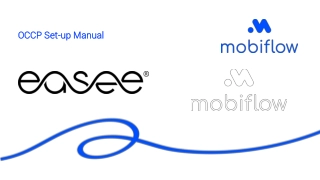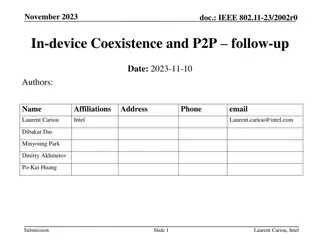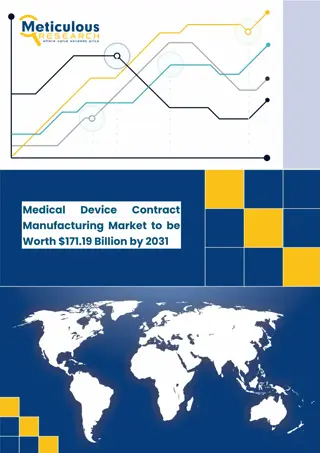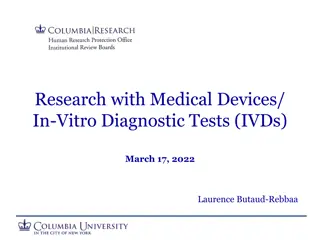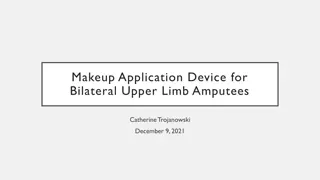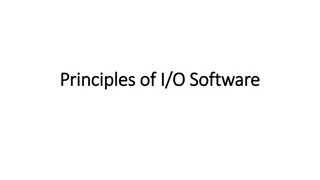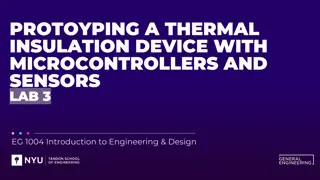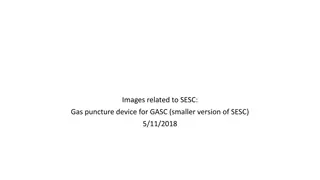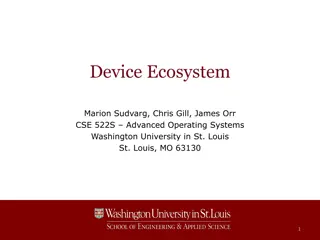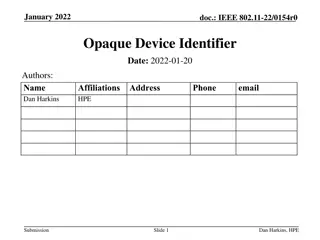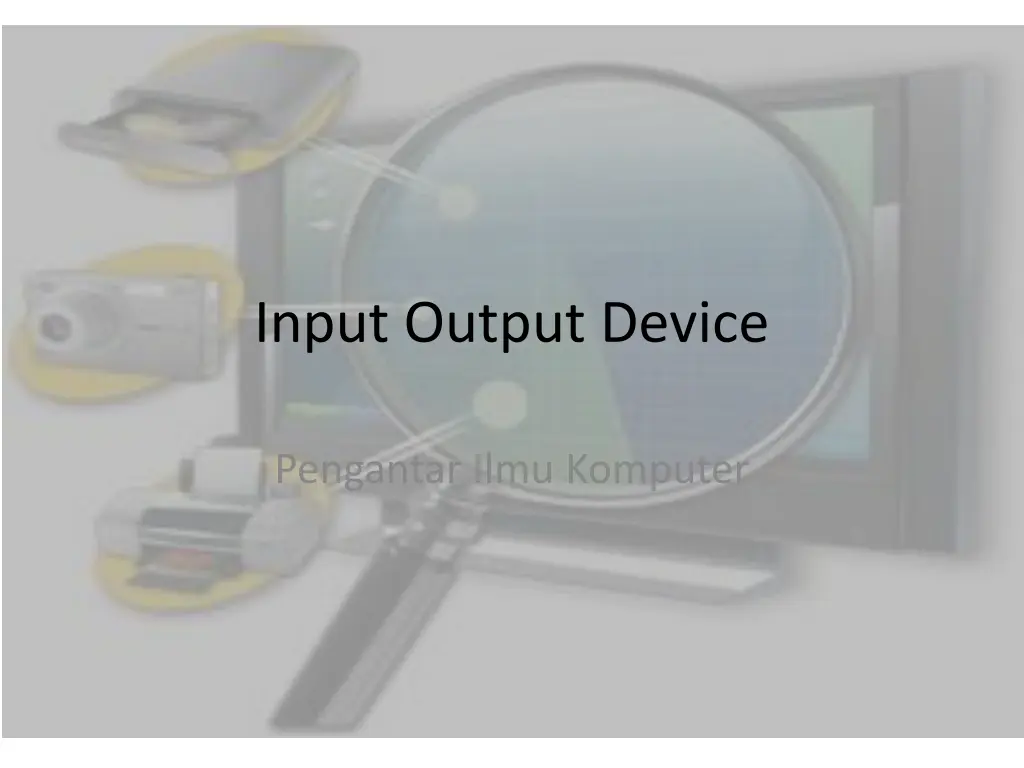
Understanding Input and Output Devices in Computer Science
"Learn about input and output devices in computer science, including definitions, types of input, terminals, and keyboard technologies. Explore the role of various devices in information processing systems like computers and their communication capabilities."
Uploaded on | 0 Views
Download Presentation

Please find below an Image/Link to download the presentation.
The content on the website is provided AS IS for your information and personal use only. It may not be sold, licensed, or shared on other websites without obtaining consent from the author. If you encounter any issues during the download, it is possible that the publisher has removed the file from their server.
You are allowed to download the files provided on this website for personal or commercial use, subject to the condition that they are used lawfully. All files are the property of their respective owners.
The content on the website is provided AS IS for your information and personal use only. It may not be sold, licensed, or shared on other websites without obtaining consent from the author.
E N D
Presentation Transcript
Input Output Device Pengantar Ilmu Komputer
Definition Input Device : any peripheral (piece of computer hardware equipment) used to provide data and control signals to an information processing system such as a computer or other information appliance
Types of Input Types of input : Signal Input Data Maintenance Input Program
Terminal Terminal A device that enables you to communicate with a computer. Generally, a terminal is a combination of input device and output device.
Types Of Terminal dumb terminal: has no processing capabilities. It relies entirely on the computer's processor. smart terminal: contains some processing power, but not as much as an intelligent terminal. intelligent terminal (programmable Terminal): a stand-alone device that contains main memory and a CPU.
Dumb Terminal Zenith Z 19
Input Devices Types Keyboard keyboard is a typewriter-style device, which uses an arrangement of buttons or keys, to act as mechanical levers or electronic switches. basic design by Christopher Latham at 1868 and marketed 1877 by Remington.
Keyboard Types Keyboard types : 1. Qwerty Keyboard is the most common modern-day keyboard layout. The name comes from the first six letters (keys) appearing in the top left letter row of the keyboard, read left to right: Q-W-E-R-T-Y. The QWERTY design is based on a layout created for the Sholes and Glidden typewriter and sold to Remington in the same year, when it first appeared in typewriters. It became popular with the success of the Remington No. 2 of 1878, and remains in use on electronic keyboards due to the network effect of a standard layout and a belief that alternatives fail to provide very significant advantages.
Keyboard Types (2) 2. Concept Keyboard Keyboard with special design Dvorak Keyboard A keyboard designed for speed typing. The Dvorak keyboard was designed in the 1930s by August Dvorak, a professor of education, and his brother-in-law, William Dealy. Unlike the traditional QWERTY keyboard, the Dvorak keyboard is designed so that the middle row of keys includes the most common letters. In addition, common letter combinations are positioned in such a way that they can be typed quickly. In addition to the standard Dvorak keyboard, there are two additional Dvorak keyboards, a left-handed and right-handed keyboard. These keyboards are designed for people who have only one hand for typing.
Keyboard Types (3) Chord Keyboard A keyset or chorded keyboard (also called a chorded keyset, chord keyboard or chording keyboard) is a computer input device that allows the user to enter characters or commands formed by pressing several keys together, like playing a "chord" on a piano. Numeric Keyboard A numeric keypad, numpad or tenkey, is the small, palm-sized, seventeen key section of a computer keyboard, usually on the very far right. The numeric keypad features digits 0 to 9, addition (+), subtraction ( ), multiplication (*) and division (/) symbols, a decimal point (.) and Num Lock and Enter keys.
Chord Keyboard Senotype Keyboard Palantype Keyboard
Input Devices Types (2) Mouse A mouse is a pointing device that functions by detecting two-dimensional motion relative to its supporting surface. Physically, a mouse consists of an object held under one of the user's hands, with one or more buttons.
Input Devices Types (3) Scanner is a device that optically scans images, printed text, handwriting, or an object, and converts it to a digital image.
Input Devices Types (4) Digital Camera a camera that takes video or still photographs by recording images on an electronic image sensor. Mic is an acoustic-to-electric transducer or sensor that converts sound into an electrical signal
Output Devices is any piece of computer hardware equipment used to communicate the results of data processing carried out by an information processing system (such as a computer) which converts the electronically information into human-readable form generated
Output Device Classification Output device classification from output Form 1. Hardcopy Device 2. Softcopy Device 3. Drive device
Output Devices (2) Smart Card A smart card, chip card, or integrated circuit card (ICC) is any pocket-sized card with embedded integrated circuits. Smart cards are made of plastic, generally polyvinyl chloride, but butadiene styrene or polycarbonate. sometimes acrylonitrile Smart cards can provide identification, authentication, data storage and application processing. Smart cards may provide strong security authentication for single sign-on (SSO) within large organizations.
Output Devices (3) Biometrics Biometrics refers to the identification of humans by their characteristics or traits. Biometrics is used in computer science as a form of identification and access control. It is also used to identify individuals in groups surveillance. (or biometric authentication) that are under
Output Devices (4) Haptics Haptic technology, or haptics, is a tactile feedback technology which takes advantage of the sense of touch by applying forces, vibrations, or motions to the user. This mechanical stimulation can be used to assist in the creation of virtual objects in a computer simulation, to control such virtual objects, and to enhance the remote control of machines and devices (telerobotics). It has been described as "doing for the sense of touch what computer graphics does for vision".Haptic devices may incorporate tactile sensors that measure forces exerted by the user on the interface.
Output Devices (5) Wearable Computer Private Eye TM(Reflection Technology) Wearable Computer International) TM (Computing Devices
Output Devices (6) Sixth Sense SixthSense' is a wearable gestural interface that augments the physical world around us with digital information and lets us use natural hand gestures to information. interact with that
Output Devices (7) Helmet Mounted Display A helmet-mounted pronounced "H-mount-D") is a device used in some modern aircraft, especially combat aircraft display (HMountD -
Smart Clothes Smart Clothes "Smart Clothing" is made from fabrics that are wireless and washable computing fibers and materials into the integrity of the fabrics. that integrate
Questions 1. Find Input and output device for certain tasks! Describe about the technology and task 2. Find information about printer types and how it works! 3. Find information about monitor types, and describe its weaknesses and strength! 4. Describe which biometric technologies you used before and what for? Give your opinion which technologies will booming in the future, write your reasons!


